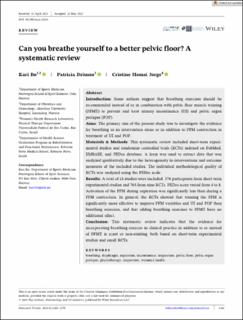| dc.contributor.author | Bø, Kari | |
| dc.contributor.author | Driusso, Patricia | |
| dc.contributor.author | Jorge, Cristine Homsi | |
| dc.date.accessioned | 2023-10-12T12:57:34Z | |
| dc.date.available | 2023-10-12T12:57:34Z | |
| dc.date.created | 2023-06-20T10:55:10Z | |
| dc.date.issued | 2023 | |
| dc.identifier.citation | Neurourology and Urodynamics. 2023, 42(6), Side 1261-1279. | en_US |
| dc.identifier.issn | 0733-2467 | |
| dc.identifier.uri | https://hdl.handle.net/11250/3096158 | |
| dc.description | This is an open access article under the terms of the Creative Commons Attribution‐NonCommercial License, which permits use, distribution and reproduction in any medium, provided the original work is properly cited and is not used for commercial purposes. | en_US |
| dc.description.abstract | Introduction: Some authors suggest that breathing exercises should be recommended instead of or in combination with pelvic floor muscle training (PFMT) to prevent and treat urinary incontinence (UI) and pelvic organ prolapse (POP).
Aims: The primary aim of the present study was to investigate the evidence for breathing as an intervention alone or in addition to PFM contraction in treatment of UI and POP.
Materials & Methods: This systematic review included short-term experimental studies and randomize controlled trials (RCTs) indexed on PubMed, EMBASE, and PEDro database. A form was used to extract data that was analyzed qualitatively due to the heterogeneity in interventions and outcome measures of the included studies. The individual methodological quality of RCTs was analyzed using the PEDro scale.
Results: A total of 18 studies were included, 374 participants from short-term experimental studies and 765 from nine RCTs. PEDro score varied from 4 to 8. Activation of the PFM during expiration was significantly less than during a PFM contraction. In general, the RCTs showed that training the PFM is significantly more effective to improve PFM variables and UI and POP than breathing exercises, and that adding breathing exercises to PFMT have no additional effect.
Conclusion: This systematic review indicates that the evidence for incorporating breathing exercise in clinical practice in addition to or instead of PFMT is scant or non-existing, both based on short-term experimental studies and small RCTs. | en_US |
| dc.language.iso | eng | en_US |
| dc.subject | breathing | en_US |
| dc.subject | diaphragm | en_US |
| dc.subject | expiration | en_US |
| dc.subject | incontinence | en_US |
| dc.subject | inspiration | en_US |
| dc.subject | pelvic floor | en_US |
| dc.subject | pelvic organ prolapse | en_US |
| dc.subject | physiotherapy | en_US |
| dc.subject | respiration | en_US |
| dc.subject | women's health | en_US |
| dc.title | Can you breathe yourself to a better pelvic floor?: A systematic review | en_US |
| dc.type | Peer reviewed | en_US |
| dc.type | Journal article | en_US |
| dc.description.version | publishedVersion | en_US |
| dc.rights.holder | © 2023 The Authors | en_US |
| dc.source.pagenumber | 1261-1279 | en_US |
| dc.source.volume | 42 | en_US |
| dc.source.journal | Neurourology and Urodynamics | en_US |
| dc.source.issue | 6 | en_US |
| dc.identifier.doi | 10.1002/nau.25218 | |
| dc.identifier.cristin | 2156115 | |
| dc.description.localcode | Institutt for idrettsmedisinske fag / Department of Sports Medicine | en_US |
| cristin.ispublished | true | |
| cristin.fulltext | original | |
| cristin.qualitycode | 1 | |
